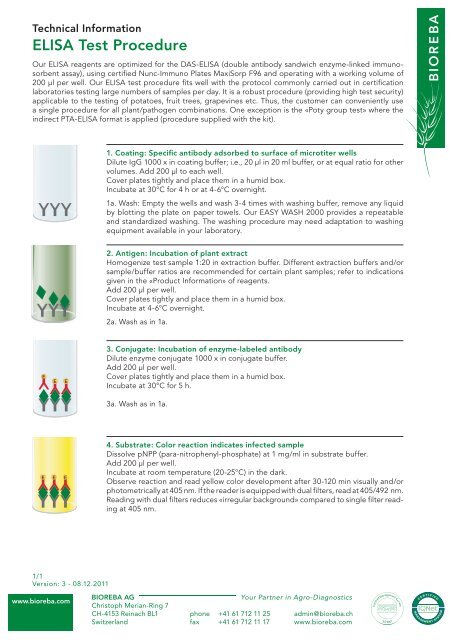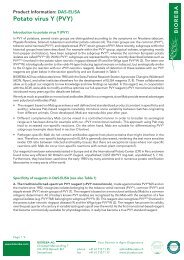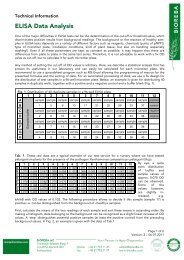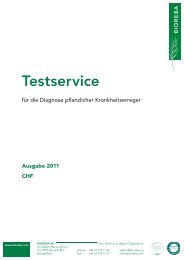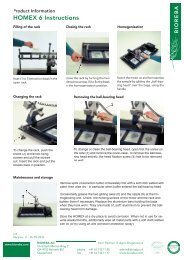ELISA Test Procedure
ELISA Test Procedure
ELISA Test Procedure
Create successful ePaper yourself
Turn your PDF publications into a flip-book with our unique Google optimized e-Paper software.
Technical Information<br />
<strong>ELISA</strong> <strong>Test</strong> <strong>Procedure</strong><br />
Our <strong>ELISA</strong> reagents are optimized for the DAS-<strong>ELISA</strong> (double antibody sandwich enzyme-linked immunosorbent<br />
assay), using certified Nunc-Immuno Plates MaxiSorp F96 and operating with a working volume of<br />
200 μl per well. Our <strong>ELISA</strong> test procedure fits well with the protocol commonly carried out in certification<br />
laboratories testing large numbers of samples per day. It is a robust procedure (providing high test security)<br />
applicable to the testing of potatoes, fruit trees, grapevines etc. Thus, the customer can conveniently use<br />
a single procedure for all plant/pathogen combinations. One exception is the «Poty group test» where the<br />
indirect PTA-<strong>ELISA</strong> format is applied (procedure supplied with the kit).<br />
1/1<br />
Version: 3 - 08.12.2011<br />
www.bioreba.com<br />
1. Coating: Specific antibody adsorbed to surface of microtiter wells<br />
Dilute IgG 1000 x in coating buffer; i.e., 20 μl in 20 ml buffer, or at equal ratio for other<br />
volumes. Add 200 μl to each well.<br />
Cover plates tightly and place them in a humid box.<br />
Incubate at 30°C for 4 h or at 4-6°C overnight.<br />
1a. Wash: Empty the wells and wash 3-4 times with washing buffer, remove any liquid<br />
by blotting the plate on paper towels. Our EASY WASH 2000 provides a repeatable<br />
and standardized washing. The washing procedure may need adaptation to washing<br />
equipment available in your laboratory.<br />
2. Antigen: Incubation of plant extract<br />
Homogenize test sample 1:20 in extraction buffer. Different extraction buffers and/or<br />
sample/buffer ratios are recommended for certain plant samples; refer to indications<br />
given in the «Product Information» of reagents.<br />
Add 200 μl per well.<br />
Cover plates tightly and place them in a humid box.<br />
Incubate at 4-6°C overnight.<br />
2a. Wash as in 1a.<br />
3. Conjugate: Incubation of enzyme-labeled antibody<br />
Dilute enzyme conjugate 1000 x in conjugate buffer.<br />
Add 200 μl per well.<br />
Cover plates tightly and place them in a humid box.<br />
Incubate at 30°C for 5 h.<br />
3a. Wash as in 1a.<br />
4. Substrate: Color reaction indicates infected sample<br />
Dissolve pNPP (para-nitrophenyl-phosphate) at 1 mg/ml in substrate buffer.<br />
Add 200 μl per well.<br />
Incubate at room temperature (20-25°C) in the dark.<br />
Observe reaction and read yellow color development after 30-120 min visually and/or<br />
photometrically at 405 nm. If the reader is equipped with dual filters, read at 405/492 nm.<br />
Reading with dual filters reduces «irregular background» compared to single filter reading<br />
at 405 nm.<br />
BIOREBA AG Your Partner in Agro-Diagnostics<br />
Christoph Merian-Ring 7<br />
CH-4153 Reinach BL1 phone +41 61 712 11 25 admin@bioreba.ch<br />
Switzerland fax +41 61 712 11 17 www.bioreba.com
Information technique<br />
Mode opératoire du test <strong>ELISA</strong><br />
Sauf exception, nos réactifs <strong>ELISA</strong> sont optimisés pour être utilisés dans un test en double sandwich (DAS-<strong>ELISA</strong>)<br />
sur des microplaques de titration Nunc certifiées avec un volume utile de 200 µl par puit. Lorsque une autre<br />
procédure est utilisée, celle-ci est clairement spécifiée à la fiche de données du réactif.<br />
Le principe des tests <strong>ELISA</strong> de BIOREBA correspond au protocole généralement utilisé dans les laboratoires de<br />
certification réalisant de nombreuses analyses en routine. C’est une procédure «robuste» qui a largement fait ses<br />
preuves et qui optimise la fiabilité des résultats. Ainsi les clients utilisent un protocole identique et fiable pour<br />
toutes les combinaisons plantes/pathogènes.<br />
1/1<br />
Version: 3 - 08.12.2011<br />
www.bioreba.com<br />
1. Coating: Sensibilisation des microplaques avec un anticorps spécifique<br />
Diluer au 1/1000 les anticorps de coating (IgG) dans le tampon de coating ; i.e. 20 µl IgG dans 20 ml<br />
de tampon. Ajouter 200 µl de la solution obtenue dans chaque puit de la microplaque.<br />
Couvrir les plaques et placer les dans une étuve humide.<br />
Incuber 4 h à 30°C ou une nuit à + 4°C.<br />
1a. Lavage : Vider les plaques et laver les au moins 3 fois avec le tampon de lavage. Eliminer<br />
tout le liquide en tapant les plaques sur du papier absorbant. Le laveur de microplaque<br />
BIOREBA «EASY WASH 2000» permet un lavage optimum.<br />
2. Echantillon: Incubation de l’extrait de plante (antigène)<br />
Diluer l’extrait végétal au 1/20 dans le tampon d’extraction (la nature du tampon d’extraction<br />
ainsi que le taux de dilution peut varier selon les échantillons; se reporter à la fiche<br />
«information produit» du réactif).<br />
Ajouter 200 µl par puit.<br />
Couvrir les plaques et placer les dans une étuve humide.<br />
Incuber une nuit à + 4°C.<br />
2a. Laver comme en 1a.<br />
3. Conjugué: Incubation avec les anticorps conjugués à l’enzyme (conjugate)<br />
Diluer au 1/1000 les anticorps conjugués dans le tampon de conjugué.<br />
Ajouter 200 µl de la solution obtenue par puit.<br />
Couvrir les plaques et placer les dans une étuve humide.<br />
Incuber 5 h à 30°C.<br />
3a. Laver comme en 1a.<br />
4. Substrat: Une réaction colorée indique la présence d’un échantillon infecté<br />
Diluer les pastilles de substrat pNPP à 1 mg/ml dans le tampon de substrat.<br />
Ajouter 200 µl de la solution obtenue par puit.<br />
Incuber à température ambiante (18 - 25°C) à l’obscurité.<br />
Observez la réaction et notez le développement de la coloration entre 30 et 120 min,<br />
soit visuellement soit avec un photomètre à 405 nm. Les photomètres à double lecture<br />
405/492 nm permettent de réduire les effets de bruits de fond.<br />
BIOREBA AG Your Partner in Agro-Diagnostics<br />
Christoph Merian-Ring 7<br />
CH-4153 Reinach BL1 phone +41 61 712 11 25 admin@bioreba.ch<br />
Switzerland fax +41 61 712 11 17 www.bioreba.com
Technische Information<br />
<strong>ELISA</strong> <strong>Test</strong>vorschrift<br />
Unsere <strong>ELISA</strong> Reagenzien sind optimiert für den Gebrauch im DAS-<strong>ELISA</strong> Format (double antibody sandwich<br />
enzyme-linked immunosorbent assay) unter Verwendung von zertifizierten Nunc Maxisorp Microtiterplatten und<br />
einem Arbeitsvolumen von 200 µl pro Vertiefung. Wenn ausnahmsweise ein anderes <strong>Test</strong>format zur Anwendung<br />
kommt, ist dies im Datenblatt der entsprechenden Reagenzien vermerkt.<br />
Diese <strong>Test</strong>vorschrift ist bestens für Zertifikationslabors geeignet, welche täglich eine grosse Anzahl von Proben<br />
verarbeiten. Diese Vorschrift bietet eine hohe Sicherheit und findet ihre Anwendung bei <strong>Test</strong>s von Kartoffeln,<br />
Fruchtbäumen, Reben, etc. Dies gewährleistet, dass der Kunde dasselbe Verfahren für alle Pathogen/Wirtspflanzen-<br />
Kombinationen verwenden kann.<br />
1/1<br />
Version: 3 - 08.12.2011<br />
www.bioreba.com<br />
1. Coating: Spezifischer Antikörper (IgG) wird auf die Oberfläche der Mikrotiterplatten gebunden<br />
Verdünnen Sie das IgG 1000 x in Beschichtungspuffer (=coating buffer); d.h. 20 µl in 20 ml<br />
Puffer, oder in einem gleichen Verhältnis bei anderen Volumina.<br />
Geben Sie 200 µl in jede Vertiefung.<br />
Bedecken Sie die Platten und inkubieren Sie sie in einem mit feuchten Tüchern oder Papier<br />
ausgelegten Behälter bei 30°C während 4 h oder bei 4 °C über Nacht.<br />
1a. Waschen: Leeren Sie die Vertiefungen und waschen Sie 3 - 4 mal mit Waschpuffer.<br />
Entfernen Sie die verbleibende Flüssigkeit, indem Sie die Platten kurz auf saugfähigem<br />
Papier ausklopfen. Der Mikrotiterplatten-Wascher «EASY WASH 2000» von BIOREBA<br />
gewährleistet ein optimales Waschresultat.<br />
2. Antigen: Inkubation des Pflanzenextraktes<br />
Homogenisieren Sie die Proben 1:20 (w/v) in Extraktionspuffer (je nach Art der Pflanzenprobe<br />
werden in der jeweiligen Produkteinformation der Reagenzien spezielle Extraktionspuffer<br />
und/oder ein anderes Probe/Puffer-Verhältnis angegeben).<br />
Geben Sie 200 µl in jede Vertiefung.<br />
Bedecken Sie die Platten und inkubieren Sie sie in einem mit feuchten Tüchern oder Papier<br />
ausgelegten Behälter bei 4 °C über Nacht.<br />
2a. Waschen wie in 1a.<br />
3. Konjugat: Inkubation mit enzym-markiertem Antikörper<br />
Verdünnen Sie das IgG-Enzym-Konjugat 1000 x in Konjugatpuffer.<br />
Geben Sie 200 µl in jede Vertiefung.<br />
Bedecken Sie die Platten und inkubieren Sie sie in einem mit feuchten Tüchern oder Papier<br />
ausgelegten Behälter bei 30°C während 5 h.<br />
3a. Waschen wie in 1a..<br />
4. Substrat: Farbreaktion bedeutet infizierte Probe<br />
Lösen Sie 1 mg/ml p-nitrophenyl phosphate (pNPP) in Substratpuffer.<br />
Geben Sie 200 µl in jede Vertiefung.<br />
Inkubieren Sie die Platten bei Raumtemperatur (18 - 25°C) im Dunkeln.<br />
Beobachten Sie die Farbreaktion und schätzen Sie die Intensität der gelben Färbung nach<br />
30-120 min entweder visuell oder messen Sie mit einem Photometer bei 405 nm. Beste<br />
Ergebnisse werden erzielt, indem neben 405 nm zusätzlich mit einer Referenzwellennlänge<br />
von 492 nm gemessen wird und Platten-Unregelmässigkeiten dabei kompensiert werden<br />
BIOREBA AG Your Partner in Agro-Diagnostics<br />
Christoph Merian-Ring 7<br />
CH-4153 Reinach BL1 phone +41 61 712 11 25 admin@bioreba.ch<br />
Switzerland fax +41 61 712 11 17 www.bioreba.com
Información técnica<br />
Procedimiento del test <strong>ELISA</strong><br />
(<strong>ELISA</strong> es un acrónimo de «enzyme-linked immunosorbent assay»)<br />
Nuestros reactivos <strong>ELISA</strong> se han optimizado para su uso en el procedimiento denominado de doble anticuerpo<br />
ó «sandwich» (DAS-<strong>ELISA</strong>), utilizando placas para microtitulación «Nunc Certified Maxisorp microtiter plates» y<br />
operando con un volumen de 200 microlitros por celda. Si se usan otros procedimientos (excepcionalmente), Usted<br />
encontrará una indicación en la hoja informativa del reactivo.<br />
Nuestro procedimiento es adecuado para ser usado en los protocolos de laboratorios orientados a la certificación que<br />
usualmente testan un amplio numero de muestras por día. Es un procedimiento altamente seguro (provee alta seguridad<br />
en el test) para su aplicación en análisis de papas (patatas), árboles frutales, vid, etc.; de esta manera, el cliente que utiliza<br />
nuestros reactivos usa un solo procedimiento, para la mayoría de las combinaciones de patógeno/hospedero..<br />
1/1<br />
Version: 3 - 08.12.2011<br />
www.bioreba.com<br />
1. Recubrimiento (vestido): Un anticuerpo especifico es adherido a la superficie de<br />
las celdas de la placa de microtitulación<br />
Diluir la IgG 1000x en el buffer de vestido (Coating buffer); por ejemplo, 20 microlitros en<br />
20 mililitros de buffer, ó bien la misma dilución con otros volúmenes.<br />
Adicionar 200 microlitros de la dilución a cada celda (hoyo).<br />
Tapar la placa logrando un buen sellado, y colocarla en caja húmeda.<br />
Incubar a 30ºC por 4 horas ó a 4ºC durante toda la noche.<br />
1º Lavado: Vaciar las celdas (hoyos) y lavar 3 - 4 veces con el buffer de lavado (Washing Buffer).<br />
Remover completamente el liquido golpeando enérgicamente la placa sobre una toalla de papel.<br />
El procedimiento de lavado se adaptará al equipo de lavado, disponible en su laboratorio.<br />
2. Antígeno: Incubación del extracto de macerado de la muestra (tejidos de la planta)<br />
Macerar la muestra y homogeneizar diluyendo 1 : 20 (u otras diluciones tal como se recomienda<br />
en la hoja informativa del reactivo) en buffer de muestra (extraction buffer). Se recomiendan<br />
diferentes buffers para diluir muestras de ciertas especies de plantas ó ciertos tejidos, ver hoja<br />
informativa del reactivo.<br />
Adicionar 200 microlitros de la dilución a cada celda (hoyo).<br />
Tapar la placa logrando un buen sellado y colocarla en caja húmeda.<br />
Incubar la placa a 4 ºC durante toda la noche.<br />
2º Lavado: Repetir el procedimiento indicado para 1º Lavado.<br />
3. Conjugado: Incubación de la IgG conjugada con la enzima<br />
Diluir la IgG conjugada con la enzima 1000x en buffer de conjugado (Conjugate Buffer).<br />
Adicionar 200 microlitros de la dilución por celda (hoyo).<br />
Tapar la placa logrando un buen sellado y colocarla en caja húmeda.<br />
Incubar a 30ºC por 5 horas.<br />
3º Lavado: Repetir el procedimiento indicado para 1º Lavado.<br />
4. Sustrato de la enzima : una reacción de color indica una muestra con infección<br />
Diluir el sustrato de la enzima (p-nitrophenyl phosphate) utilizando 1 mg/ml en buffer de sustrato<br />
(substrate buffer).<br />
Adicionar 200 microlitros de la dilución por celda (hoyo).<br />
Incubar a temperatura ambiente (18 - 25°C) en oscuridad.<br />
Luego de 30 - 120 minutos observar el desarrollo de la reacción de color amarillo; registrar los resultados<br />
visualmente y/o mediante la medición de la absorbancia (OD) a 405 nm. Si el equipo de lectura está<br />
equipado con filtros duales, leer a 405/492 nm. La lectura mediante la utilización de doble filtro reduce<br />
el «fondo irregular de la placa», si se la compara con la lectura utilizando un solo filtro a 405 nm<br />
BIOREBA AG Your Partner in Agro-Diagnostics<br />
Christoph Merian-Ring 7<br />
CH-4153 Reinach BL1 phone +41 61 712 11 25 admin@bioreba.ch<br />
Switzerland fax +41 61 712 11 17 www.bioreba.com


